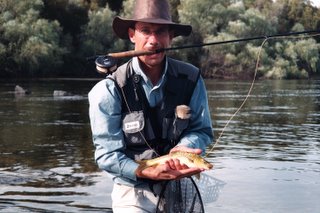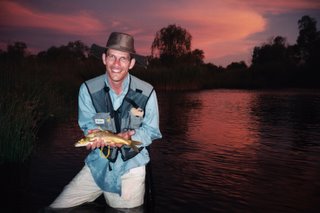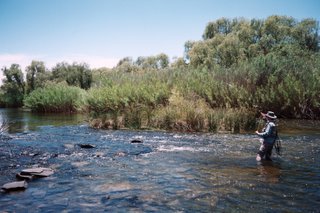As a visitor to Bloemfontein, I saw the most fantastic sight inside the building of the Department of Agriculture and Environmental Affairs. I visited this building to apply for a fishing licence. The office responsible for issuing these licences was surprisingly easy to find, considering that the only signposting was a trail of arrows printed out on a deskjet somewhat low on toner.
Eventually after following a trail of these faded printouts through a number of corridors, I arrived at the Conservation Directorate: Fishing Licences, 3rd Floor, Northwing Building. Looking at the counter, I realised that I was face-to-face with height of bureaucratic design principles. The genius of bureaucratic design is that it is an impersonal and faceless application of a rational-legal system. In front of me the glass-fronted counter of the Conservation Directorate: Fishing Licences, 3rd Floor, Northwing Building shone gold and reflected my own surprised expression back at me: It took me a few seconds, before I realised that I faced a one-way mirror.
From my side it is impossible to see the face of the clerk assigned to process me, but of course, the clerk has a clear view of the applicant to be processed according to the rational-legal principles that the Conservation Directorate decided upon. I found it quite hard to communicate, especially because facing your own puzzled reflection makes it hard to maintain the belief that there is actually a diligent clerk on the other side of the glass.
Where the mirror meets the veneered countertop, there was an opening cut in the glass, precisely to the width of a Free State Province fishing licence document and about ten centimetres high. I put my cheek flat on the countertop and tried to speak to the clerk through the hole. Now, if only he also would have put his head flat on his side, then we could speak eye-to-eye. To my dismay, and the detriment of the quality of our interaction, the clerk failed to reciprocate. I assume he must have seen this kind of manoeuvre before, because he spoke to me as if everything was normal, even though I was speaking to his belt buckle.
To avoid further embarrassment, I straightened up, looked myself in the eye and pretended to rehearse a speech. Then I sealed my fate by asking my reflection who decided to put this unfriendly glass in. I could hear his footsteps as he moved away from the counter. I continued speaking to my reflection, only this time no response came from the other side of the glass. I made a face in the mirror – just for the hell of it.
I clicked my heels to attention, gave my best salute, did an about turn and marched out wondering about Chief Director Monde Walaza - the person who heads the office of the Conservation Directorate: Fishing Licences, 3rd Floor, Northwing Building. Surely he is responsible for the golden mirror of bureaucracy.
I am wondering how could Chief Director Monde Walaza so quickly forget the eighties in South Africa? Can he not remember the time of one-way mirrors in government interrogation rooms from behind which those in power anonymously observed those who dared resist the way the state decided to process their lives?




